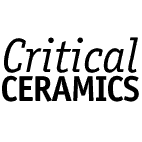









Hi, Forrest!
Oh, my. I just reread my proposal and c. v. [see below, ed.] � they were written nearly a year ago. Gosh, it’s a bit embarrassing to think of the state I was in while writing them (state: frantic), and please excuse the overall scattered tone. Mind you, in trying to convince the committee to give me funding, I realized some pretty ambitious plans were laid out. Ah-hem, now that it’s the day before I embark on all this, I’m feeling a tad more humble and let’s just say I’m more confident about the accuracy of my c.v. than the proposal. But I hope they give you an idea, even if vague, of what the Fulbright is kindly supporting.
Even to promote my mission even some more, I also included some Fulbright information. Senator William Fulbright has some pretty powerful things to say.
So, yep, clay and world peace � I look forward to sharing sights, smells, sounds and all the other goodies that my senses pick up as I bumble my way through.
As for now, I must pack, I must go to the Post Office, I must go to the bank, I must buy candy for the plane ride.
Here we go!
Angela
I am a senior at the New York State College of Ceramics at Alfred University School of Art and Design. I received my first undergraduate degree in East Asian Studies from Columbia College, Columbia University in 1993.
I was born in Manhattan and raised in Queens. Art has always been an integral part of my life but during high school my interests became more focused on academics and my heritage.
My father is a chef and my mother works for the Greenwich Japanese School. Through them, I was exposed to the intimate details of Japanese culture. As I grew older, I wanted to learn more about Japanese history, literature, religion, film, art, music, and pop culture. Therefore I studied at Columbia.
For four years, I was engrossed. Aside from academics, I lived in Japan House (a special interest dormitory). For two summers, I worked as an interpreter for the New York - Tokyo Sister City Program’s Nanshiki Baseball Tournaments. Other places of employment were Kinokuniya Bookstores and Telecom Japan International, a Japanese television production company. On campus, I worked at the Institute for Medieval Japanese Studies which eventually lead to a full time position after graduating.
Through the Institute I met renown Japanese scholars, writers, artists, psychoanalysts, and religious leaders. I was living my dream of learning as much as possible about Japan, but by this time I also realized that I did not want to pursue my academic major on a professional level.
As my cultural identity became defined, I also became reacquainted with a personal identity which basically had not changed since age three. I am an artist.
I try to guide my work by instinct and attempt to celebrate emotion. It is difficult. The intellect can be paralyzing. Since matriculating at Alfred, I found it necessary to untrain certain academic schools of thought while decidedly preserving others. I once tried to separate this new phase of life from old. From New York City to a town of 4600, I saw many differences. To my surprise, a tiny town revealed a new world. I realized the importance of exposure to different environments, different people, different ideas. A metropolis rich in art and culture told me “This is it”. A village with only one block of stores assured me “... there is this also”.
I no longer attempt to separate the now from then. Childhood memories, random recollections, experiences at Columbia, and the present all help me create things with clay. The expansive nature of the material is a constant reminder to be flexible in thought. The realistic limitations of the medium is humbling. As I am bombarded by curiosities, my work method is slow and systematic.
I associate my work with the abstract. This is for wider accessibility. Other art inspires and helps me. My heritage is personal and my art is personal, therefore my heritage plans an active role in the thought process involved in creating, but I decline from being classified as an Asian-American or Japanese-American artist. I am proud, though, to be able to comfortably associate with two cultures.
In the future, I see myself teaching.




